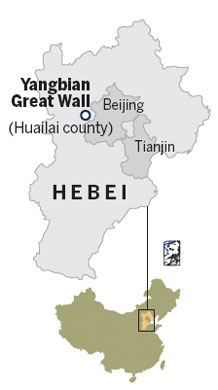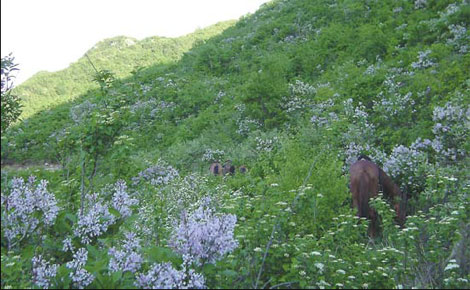 |
| A horseback ride to the Yangbian Great Wall is the real deal for many aficionados who try to seek a rugged and pristine climb. Alexis Hooi / China Daily |
Feasting on the Great Wall under the stars is the stuff of dreams for many visitors to Beijing. Alexis Hooi takes the experience further by joining a group of horseback riders to scale a little-known but historic section of the fortification.
Less than 100 km northwest of downtown Beijing lies the Yangbian section of the Great Wall, in Huailai county of Hebei province. Unlike more popular sites such as Badaling and Mutianyu, this part of the wall stands broken and remains untouched by renovation. As such, Yangbian is the real deal for many Great Wall aficionados seeking a rugged and pristine climb up one of the wonders of the world.Yangbian also offers an interesting nugget for the history buff.
A number of historians armed with comparative photographs claim that it was through this part - and not the famous Juyongguan pass - that Japanese troops broke through on Aug 20, 1937, during the initial stages of the War of Resistance against Japanese Aggression.
All these seemed too good to resist for our group of a dozen horseback riders, who decide to explore one route to Yangbian this summer.
We set off from Taishizhuang village near the Guanting reservoir, where the Yeshulin equestrian club prepare our steeds and supplies for the two-day trek.
Guanting reservoir, located in Beijing's Yanqing county, is a popular weekend destination for many Beijingers wanting to get away from the city to enjoy nature. Rows of humming wind turbines tower above the banks of the reservoir, acting as green sentinels to a water source that became unfit for drinking decades ago because of pollution and is now only suitable for agricultural use.
On a clear day, the mountain ranges further in the northwest form a breathtaking backdrop for the glistening surface of the reservoir. The waters also support waterfowl paddling among clumps of reeds that help break gentle waves lapping against the shores.
After a bracing ride along the southern edge of Guanting, the scenery change dramatically as we arrive at the Tianmo desert area. The patch of sand is the closest of its kind to the capital and is usually used by film crews to shoot desert scenes. Fueled by a brief beer stop at a farmer's shack on the fringe of Tianmo, a few riders blazing ahead at the front of our team chance upon prop villages complete with earthen ramparts and tower gates.
Liang Cheng, a 45-year-old local farmer, says it is common to come across actors, directors, producers and other film personnel in the area's lodgings during a set production.
"These entertainment people can party the whole night long when they are out here, it's quite a sight," Liang says.

We head south from Tianmo into a narrow valley that would have served as the perfect ambush spot for bandits who preyed on merchant caravans in imperial China. The air grows drier and the valley funnels thick winds of dust that penetrate our face scarves and gear.
But the air soon clears up and the highlands in the southwest - which the Yangbian section of the Wall snakes through - open up before us.
Our pack rides up the ridge into the seemingly deserted outskirts of Miaogang village, where cracking dirt-packed walls and bone-dry wells echo more prosperous times when mountain streams were probably flowing more fully.
The slopes become steeper as we make our way toward the mountain ridge and up against tougher terrain of shale and stone. We can already make out crumbled sections of the Wall against the red rays of a setting sun.
About an hour after our horses cautiously navigate up the ridge, we stand before a beige-colored stretch of Wall. Below the crumbled section is a stone tablet that reads "the Yangbian Great Wall".
We set up our camping tents just below the ramparts where the slopes protect us from the wind. We also free our horses for them to recharge on the fresh mountain grass.
Trip organizers soon transport our dinner up the slopes, including mutton skewers, an assortment of local fruit and vegetables, and freshly caught fish, all to be washed down with Chinese baijiu liquor, red wine, beer and soda luxuriously chilled with ice cubes.
Our banquet on top of the Wall stretches deep into the night as we share stories and songs, dancing around the campfire under a starry sky.
As we trace the silhouette of the Wall on the mountain ridge just above us, we can almost hear nearby wolves howling hauntingly under the bright moon - an experience not far from what Chinese troops stationed on the Wall's guard towers would have felt in earlier times.
 |
| The horses are freed on the slope to recharge on the fresh mountain grass. Alexis Hooi / China Daily |
 |
| The silhouette of the Yangbian Great Wall is made out against the red rays of a setting sun. Liu Di / for China Daily |
By Alexis Hooi (China Daily)
|